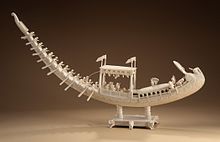Bengali traditional dress
| Part of a series on |
| Bengalis |
|---|
 |
| Part of a series on the |
| Culture of Bengal |
|---|
 |
| History |
| Cuisine |
Bengali traditional dress encompasses the clothing traditions of the Indian state of West Bengal and the country of Bangladesh. The attire has been influenced by centuries of cultural evolution, religious practices, and geographical conditions. Bengali clothing is renowned for its simplicity, elegance, and comfort while showcasing intricate artistry and vibrant designs.
Men's traditional attire
- Dhoti (ধুতি): A long piece of unstitched cloth, traditionally white or cream-colored, wrapped around the waist and legs. It is often paired with a panjabi.[3] For formal occasions and religious ceremonies, men often wear silk dhoti with intricate borders (e.g., Garad or Korial).
- Panjabi (পাঞ্জাবি): the panjabi or kurta is a knee-length tunic, commonly made of cotton, silk, or linen. It is worn during festivities, weddings, and everyday life. In winter, men may pair their panjabi with a shawl or a chadar.
- Sherwani (শেরওয়ানি): Though not native, the sherwani is worn during weddings and formal events, reflecting the Mughal influence on Bengali culture.
- Lungi (লুঙ্গি): A colorful, comfortable piece of cloth worn casually, especially in rural Bengal, for its ease of movement and practicality.
Women's traditional attire
- Saree (শাড়ি): The saree is the most iconic dress for Bengali women. It is a long piece of fabric, draped elegantly over the body. Popular Bengali sarees include:[3]
- Tant (তাঁত): A lightweight cotton saree perfect for summer.
- Baluchari (বালুচরি): Known for its intricate patterns depicting mythological scenes, woven with silk threads.
- Garad (গরদ): A white silk saree with red borders, often worn during religious festivals.
- Jamdani (জামদানি): A handwoven muslin saree with elaborate patterns, considered a UNESCO Intangible Cultural Heritage.
- Salwar Kameez (সালওয়ার কামিজ): A comfortable alternative to the saree, comprising a long tunic (kameez) paired with loose trousers (salwar) and a matching scarf (dupatta).
- Shawls and wraps: In the winter, women often use woolen or silk shawls, such as Kantha-stitch wraps, which feature handmade embroidery.
Children’s traditional attire
Source[4] Boys often wear kurta-pajama or dhoti-kurta for special occasions. Girls wear mini versions of sarees or lehenga-choli. Salwar kameez is also common among young girls.
Jewelry and accessories
- For women
- For men
- Simple gold or silver chains, rings, and sometimes ear studs are traditional for Bengali men.
Festive and ceremonial attire
Bengali festivals, such as Durga Puja, Eid-ul-Fitr, and weddings, feature unique dress codes:
- During Durga Puja, women prefer white sarees with red borders, while men wear silk dhoti-panjabi.
- For weddings, brides typically wear vibrant red or maroon Banarasi sarees, and grooms opt for silk dhoti with a kurta or sherwani.
Modern adaptations
While traditional dresses remain prominent, contemporary Bengali fashion incorporates modern styles. Sarees are now paired with designer blouses, and dhoti pants are styled with jackets for a fusion look. Western clothing such as jeans, t-shirts, and suits is common in urban areas, while rural communities continue to cherish traditional attire.
References
- ^ a b c "State Costume: West Bengal". Peachmode. Retrieved 2025-01-06.
- ^ a b c https://www.ijsr.net/archive/v13i1/SR24103165904.pdf.
{{cite journal}}: Cite journal requires|journal=(help); Missing or empty|title=(help) - ^ a b Sun, Daily (April 2018). "Evolution of Bengali Costumes". daily-sun. Retrieved 2025-01-06.
- ^ "Bengal: The confluence of fashion for two centuries -". 2017-05-16. Retrieved 2025-01-06.
